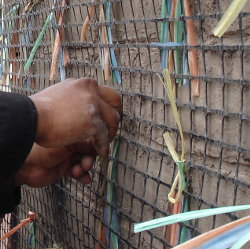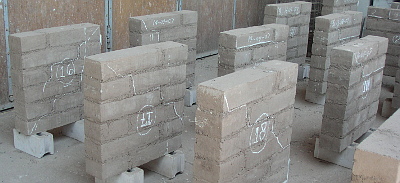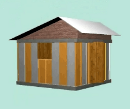Peru: Earquake resistant houses made from adobe
 In this forth contribution in our series discussing different experiences in reconstruction projects, the EcoSur E-magazine documents a Peruvian project aimed at setting the base for earthquake resistant constructions with adobe. It concentrates on the task to build permanent shelter, respecting the local culture and providing education on how to build safe, but affordable houses. It uses the traditional adobe technology which was the standard for a good and solid house until some decades ago. However, in recent times clay based constructions came under much criticism and the propaganda machinery of the cement and steel producers and traders have influenced the popular perception. Today adobe construction is viewed as unsafe and antiquated by most people.
In this forth contribution in our series discussing different experiences in reconstruction projects, the EcoSur E-magazine documents a Peruvian project aimed at setting the base for earthquake resistant constructions with adobe. It concentrates on the task to build permanent shelter, respecting the local culture and providing education on how to build safe, but affordable houses. It uses the traditional adobe technology which was the standard for a good and solid house until some decades ago. However, in recent times clay based constructions came under much criticism and the propaganda machinery of the cement and steel producers and traders have influenced the popular perception. Today adobe construction is viewed as unsafe and antiquated by most people.
After the 1970 earthquake in Huaraz, Peru, investigations on the potential for earthquake resistance of adobe buildings started and the “Pontífica Universidad Católica del Perú” (PUCP) took the lead in this endeavor. This has resulted in an official Peruvian “code of practice” for adobe construction that has been revised and improved twice. Most adobe projects in Latin America use this code as reference.
It is obvious that most inhabitants of the highlands (sierra) will build their house in adobe for years to come, it is not just for the financial advantage but also because of the appropriateness to the harsh climate. Earthquake reconstruction should take this into account and provide adequate information and training to improve the quality of adobe constructions. Thus a project is born, that does not concentrate on building, but on teaching.

Situation at the time of the emergency
The earthquake that hit Peru on August 15, 2007, in the afternoon with
a Richter Magnitude of 7.9 affected mainly the departments south of
Lima and the number of houses destroyed or seriously affected is
76,000, of which 12,000 in the rural areas and 64,000 in towns. Over
the last years Peru and specifically the affected areas have
experienced economic growth, however the situation of the large
majority of the population was still critical. The agricultural
production, the mainstay in the region, was not directly affected by
the quake, but of course activities were disrupted.
The fear of earthquakes is omnipresent in the Peruvian people, and damage is generally associated with clay based construction. Most of the housing stock is made of clay, mainly the houses of the poorer segments of the population who have little or no cash for maintenance and repair. Many of those buildings were built without proper skills, disregarding ancient construction rules. Adobe walls used to be thick and based on good foundations, but in recent decades the walls became thinner and therefore much less prepared to take the shaking of an earthquake.
 A different approach to reconstruction
A different approach to reconstruction
The PUCP has been on the forefront for the design of earthquake
resistant adobe houses for decades, they are likely the most
knowledgeable body on the subject worldwide. A group of some twenty
organizations gathered into a loose coordination and under the
technical leadership of the PUCP some of them decided on a program of
teaching improved adobe construction as a base for rural
reconstruction. This program is focusing on the long term, empowering
the poor rural population to improve the standards of their houses
built in the traditional “natural construction process”.
In the rural areas of Peru, the earth has always been the dominant construction material. Mainly in the sierra its advantages are manifold, it insulates against the cold, and the wind, it is durable and it can be owner-built as the raw material is generally available. Adobe constructions can be highly resistant to earthquakes, if built the right way and if maintained and repaired. Inspection after the earthquake shows that houses built according to the improved clay standards survived with no or very minor damage in the midst of destruction.
Each earthquake will do some damage to a building, and as repairs are usually not done correctly, the next tremor will cause more damage, and eventually the structure will crumble in a strong quake. The PUCP is developing innovative and very low cost methods of repairing cracks in adobe walls, which will revolutionize maintenance. The project promotes construction with adobe, according to the approved standards, including the latest findings of the PUCP. The thickness to height ratio of the walls is kept low, foundations and footings are of concrete, a tie beam at the top supports the roof and all walls are “packed” into a plastic mesh. Standard clay and lime plastering is applied over the netting and the earthquake safety of the building is greatly improved as compared with the traditional technology.
The teaching program
The project concentrates on teaching the technology to architects and
engineers, builders, local leaders and potential self builders. During
one week the participants learn theory and practice of production of
adobe, building up, placing the plastic mesh and plastering it
properly. The first courses were given at the university and a total
of 100 persons attended in four one-week sessions.
A simple construction guide was prepared and 5000 copies printed; for the discussion rounds with the communities they also use impressive videos showing the results of the proposed improvements in construction : real scale houses shaking and crumbling on the shaking table, structures either built with traditional technology or with various levels of the improvements. The program also includes follow up programs for maintenance, knowing this to be a most important factor in lowering vulnerability.
The Peruvian Government disbursed a reconstruction grant of 2,000 USD to many families, which allowed them to build a small house of 30m2 if they provide most labour without cost. Actual management of the construction is in the hands of the people, which allows families with some cash or with materials rescued from their collapsed house, to build a larger home right on. The newly introduced improvements (netting) add a cost of aprox. 4 USD per m2 of floor area.

Conclusions
Thus the beneficiaries have to take up action on their own and build
the house on their own. This approach will not result in massive
construction programs in the short run, but it has great possibilities
of making a lasting impact on the construction standards in the
countryside, and therefore preventing future damage in the next
earthquake that is sure to arrive one day. Experience around the world
show that the beneficiaries can reap many good deals when they are in
charge of their construction. They are free to change the design,
include extra items or make changes to the design.
The backdrop is usually that most people have little or no technical
skills and have to rely on local craftsmen and their skills of planning
and budgeting, which often are deficient. Aggressive marketing programs
for construction materials might not be the best advisor as to what
technology and materials to rely on.
That is why technical services offered by a project are important.
At the fourth EcoMaterials conference in November 2009 (www.ecomateriales.org ), Julio Vargas Neumann, the major author of the Peruvian Adobe Standards and “father” of this project, will be participating with a major presentation and open to discuss your questions.





